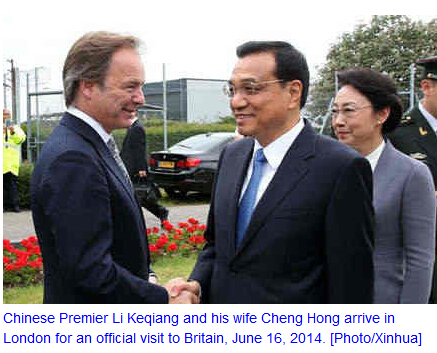以下为李克强在《泰晤士报》署名文章全文,中文部分为民间翻译,并非官方版本。
China and Britain Are on a Winning Course
中英踏上双赢之路
By H.E. Li Keqiang
中华人民共和国总理 李克强

Many countries have very high expectations of China, some even to the extent of seeing China as a global power. As the premier of China, I do have a good sense of where things stand.
许多国家对中国期望很高,有些国家甚至将中国视为世界强国。但作为中国的总理,我对中国的国情有清晰的认识。
Indeed, China has achieved a quantum leap in its development, which is regarded as a remarkable success by the international community. Thanks to the reform and opening-up process started more than 30 years ago, China has substantially improved the livelihoods of its people within a generation. Personally, I do recall vividly my experience of poverty and hunger in my youth, having been sent to work as a farm boy. By 2013, China's grain output had continuously increased over ten consecutive years and basically met the food needs of the 1.3 billion Chinese. Feeding its people has been considered as an issue "the size of Heaven" since ancient times in China.
的确,中国的发展实现了量的飞跃,国际社会都视其为卓越的成就。30多年前开启的改革开放进程,让中国人民的生活水平在一代人之内得到大幅提升。我个人年少时曾被派往农村劳动,彼时贫穷和饥饿的记忆至今仍历历在目。到2013年,中国的粮食产量已连续10年增长,基本满足了13亿人口的粮食需求。自古以来,人民温饱在中国一直被视为 “天大”的事。
At the same time, China's urbanisation process is steadily advancing, with more than half of its people now living in cities and towns. Nine-year free compulsory education is provided, covering 160 million students. A nationwide medical service network has been built, covering all its urban and rural residents. The list can go on and on.
同时,中国的城镇化进程在稳步前进,已有超过一半的人口居住在城镇。九年义务教育惠及一亿六千万学生,基本公共医疗服务覆盖全体城乡居民。这些例子不一而足。
On the other hand, we should keep in mind an old Chinese saying: "One should always be aware of the strength of others and the shortcoming of oneself." China is far from achieving its development goals. Measured by World Bank standards, more than 200 million Chinese still live below the poverty line. Development is quite uneven between urban and rural areas and among different regions, with the per capita GDP of some inland provinces being just one third of the coastal region.
另一方面,我们应牢记一句中国古话:“知己之短,学人之长。”中国距离她的发展目标还很遥远。根据世界银行的标准,超过2亿的中国人仍然生活在贫困线下。城乡、区域发展不均衡,内陆某些省份的人均GDP仅为沿海地区的三分之一。
In the process of urbanisation, China faces three pressing tasks, affecting 100 million people each: to help 100 million rural migrants enjoy resident status in cities and towns in eastern China; to accommodate 100 million rural people as local residents in cities and towns in central and western China, and to provide 100 million people living in rundown areas in cities with decent housing. These undertakings have an impact on 300 million people. It is indeed a most daunting challenge. A latecomer to modernisation and weighed down by weak economic foundations, China lags far behind the United Kingdom and other western countries in many areas. Its quest for modernisation remains a long and arduous one. As premier, my highest priority is to pursue modernisation through urbanisation and industrialisation.
城镇化进程中,中国亟需解决“三个1亿人”问题:促进1亿农业转移人口落户东部地区的城镇;引导约1亿人在中西部地区就近城镇化;改造约1亿人居住的城镇棚户区和城中村,使这些地区的居民有较好的居住条件。这些工作将影响3亿居民,是对我们巨大的挑战。作为现代化进程中的后来者,中国经济基础薄弱,在许多方面远远落后于英国和其他西方国家。中国追求现代化的道路注定艰辛而漫长。作为总理,我的首要任务是通过城镇化和工业化带动现代化。
本文关键字: 李克强在《泰晤士报》署名文章
 免费试听
免费试听

时长 : 29:45 主讲 : 乔迪

时长 : 44:09 主讲 : 徐宸

时长 : 21:15 主讲 : 徐宸

时长 : 21:15 主讲 : 徐宸

时长 : 44:09 主讲 : 徐宸

时长 : 29:45 主讲 : 乔迪

时长 : 15:31 主讲 : 徐新磊

时长 : 18:37 主讲 : 孔令金

时长 : 15:31 主讲 : 徐新磊
 推荐阅读
推荐阅读
迎春乐 柳永 近来憔悴人惊怪。为别后、相思煞。我前生、负你愁烦债。便苦恁难开解。 良夜永、牵情无计奈。锦被里、馀香犹在。
Sonnet 14 If Thou Must Love Me Elizabeth Barrett Browning If thou must love me, let it be for naught
为了帮助同学们提高英语学习能力,新东方在线英语频道整理了《英国女王发表特别讲话:我们将会重逢(中英双语)》,希望对大家有所帮助。
以下是新东方在线英语学习网给大家整理的TED演讲:20岁到30岁人生的关键期 不可挥霍的光阴(双语),希望能够帮助大家更好提高自己的英语水平,更多英语学习内容,欢迎随时关注新东方在线英语学习网。
来源 : 新东方网 2019-05-21 15:10:04 关键字 : TED演讲
十三届全国人大二次会议12日上午9时举行第三次全体会议,听取最高人民法院院长周强关于最高人民法院工作的报告,听取最高人民检察院检
新东方在线口译网为大家准备了互联网大佬们在“两会”期间都说了什么?想知道近来都有哪些热点新闻吗?新东方在线口译小编为您发布~更多双语时事的相关内容,尽在新东方口译网。
新东方在线口译网为大家准备了 国务委员兼外交部长王毅记者会双语要点。想知道近来都有哪些热点新闻吗?新东方在线口译小编为您发布~更多双语时事的相关内容,尽在新东方口译网。
新东方在线口译网为大家准备了部长语录:中国运动员会在北京冬奥会上争金夺银。想知道近来都有哪些热点新闻吗?新东方在线口译小编为您发布~更多双语时事的相关内容,尽在新东方口译网。
来源 : 中国日报网 2019-03-11 15:06:53 关键字 :
新东方在线口译网为大家准备了中国人民银行行长易纲等就“金融改革与发展”答记者问。想知道近来都有哪些热点新闻吗?新东方在线口译小编为您发布~更多双语时事的相关内容,尽在新东方口译网。
来源 : 中国日报网 2019-03-11 15:03:32 关键字 : 金融改革与发展
新东方在线口译网为大家准备了习近平在2018年中非合作论坛北京峰会开幕式讲话(双语)。想知道近来都有哪些热点新闻吗?新东方在线口译小编为您发布~更多双语时事的相关内容,尽在新东方口译网。
来源 : 网络 2018-09-13 17:32:43 关键字 : 中非合作论坛
